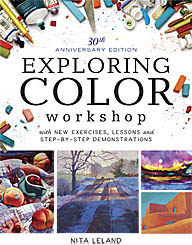Artist vs. student watercolors
My recommendation is always to use the best paint you can. Cheap paint has additives that weaken the pigment load. You have to use more paint and brush strokes to get the intensity you want instead of getting it right the first time, as with richer artist colors, which take far less paint to make intense color.
Is there any advantage at all to using cheap paint? Here are some scenarios:
You like pastel tints and hate staining colors. Buy cheap pan paints and hope they don't fade.
You love intense, staining colors and don't care about the quality. Use cheap tube colors made with synthetic dyes. Test for lightfastness.
You love richly pigmented, dense, velvety color. Use paints that don't have ox gall in them.
You hate pale washes and want rich color from every brush stroke. Use well pigmented artist colors.
You like to use unusual, exciting colors. Choose from manufacturers that have more than 50 colors in the line.
You use pouring techniques to build up thin layers of paint. Use small amounts of artist colors or large amounts of cheaper paints.
You use heavy layers of paint. Use cheaper paints if they don't show a tendency to crack.
You like a creamy, non-sticky consistency to paint. Avoid honey-based paints.
You like watercolors that won't dry and crack when left on the palette. Avoid cheap paints.
My personal preference is for paints that are highly pigmented and creamy, not juicy. I've tested many brands of watercolor and my A-list consists of Winsor & Newton (not Cotman), Holbein and Daniel Smith. Also of high quality are Rembrandt, Rowney, Old Holland, Sennelier and Schmincke. Included in the top tier are Maimeriblu and M. Graham. Artists all have their preferences, so this is a matter of opinion and experience, not carved in stone.
Is there any advantage at all to using cheap paint? Here are some scenarios:
You like pastel tints and hate staining colors. Buy cheap pan paints and hope they don't fade.
You love intense, staining colors and don't care about the quality. Use cheap tube colors made with synthetic dyes. Test for lightfastness.
You love richly pigmented, dense, velvety color. Use paints that don't have ox gall in them.
You hate pale washes and want rich color from every brush stroke. Use well pigmented artist colors.
You like to use unusual, exciting colors. Choose from manufacturers that have more than 50 colors in the line.
You use pouring techniques to build up thin layers of paint. Use small amounts of artist colors or large amounts of cheaper paints.
You use heavy layers of paint. Use cheaper paints if they don't show a tendency to crack.
You like a creamy, non-sticky consistency to paint. Avoid honey-based paints.
You like watercolors that won't dry and crack when left on the palette. Avoid cheap paints.
My personal preference is for paints that are highly pigmented and creamy, not juicy. I've tested many brands of watercolor and my A-list consists of Winsor & Newton (not Cotman), Holbein and Daniel Smith. Also of high quality are Rembrandt, Rowney, Old Holland, Sennelier and Schmincke. Included in the top tier are Maimeriblu and M. Graham. Artists all have their preferences, so this is a matter of opinion and experience, not carved in stone.
Labels: paint, paint quality, tutorials, watercolor





2 Comments:
I like the article. I'd add that Holbein doesn't use ox gall and M Graham uses honey. Plus, even artist grade paint lines may have fugitive pigments and pigments with only moderate permanence. Alizarin Crimson, Rose Madder, and Indigo are old-school examples, but others like Opera are recent.
I'd also suggest that people buy only single-pigment paint tubes. There's really no point in buying mixtures.
Thanks for the informative comment. You're right on all counts. Sennelier also uses honey. Holbein's lack of ox gall gives the paint a little more body than most watercolors and a kind of velvety finish that is attractive in medium to heavy washes. Regarding fugitive colors, yes, there are some still out there, so it's important to read the lightfastness ratings on the tubes or check them on the Web sites of the manufacturers. As for single-pigment paints, I agree this is a good idea, but I admit to having a few mixed pigments on my palette because of the convenience. The one I absolutely must have is Rembrandt Turquoise Blue. I know I can mix it, but the mixtures vary widely and when I want that color, I want it now. One of my quirks. Of many.
Post a Comment
<< Home